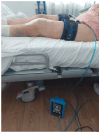Passive Blood-Flow-Restriction Exercise's Impact on Muscle Atrophy Post-Total Knee Replacement: A Randomized Trial
- PMID: 40806840
- PMCID: PMC12347597
- DOI: 10.3390/jcm14155218
Passive Blood-Flow-Restriction Exercise's Impact on Muscle Atrophy Post-Total Knee Replacement: A Randomized Trial
Abstract
Background/Objectives: Total knee arthroplasty (TKA) is commonly associated with postoperative muscle atrophy and weakness, while traditional rehabilitation is often limited by pain and patient compliance. Passive blood flow restriction (pBFR) training may offer a safe, low-threshold method to attenuate muscle loss in this early phase. This pilot study examined the feasibility, safety, and early effects of pBFR initiated during hospitalization on muscle mass, swelling, and functional recovery after TKA. Methods: In a prospective, single-blinded trial, 26 patients undergoing primary or aseptic revision TKA were randomized to either a control group (CON: sham BFR at 20 mmHg) or intervention group (INT: pBFR at 80% limb occlusion pressure). Both groups received 50 min daily in-hospital rehabilitation sessions for five consecutive days. Outcomes, including lean muscle mass (DXA), thigh/knee circumference, 6 min walk test (6 MWT), handgrip strength, and patient-reported outcomes, were assessed preoperatively and at discharge, six weeks, and three months postoperatively. Linear mixed models with Bonferroni correction were applied. Results: The INT group showed significant preservation of thigh circumference (p = 0.002), reduced knee swelling (p < 0.001), and maintenance of lean muscle mass (p < 0.01), compared with CON, which exhibited significant declines. Functional performance improved faster in INT (e.g., 6 MWT increase at T3: +23.7%, p < 0.001; CON: -7.2%, n.s.). Quality of life improved in both groups, with greater gains in INT (p < 0.05). No adverse events were reported. Conclusions: Initiating pBFR training on the first postoperative day is feasible, safe, and effective in preserving muscle mass and reducing swelling after TKA. These findings extend prior BFR research by demonstrating its applicability in older, surgical populations. Further research is warranted to evaluate its integration with standard rehabilitation programs and long-term functional benefits.
Keywords: knee arthroplasty; occlusion training; physical function; rehabilitation.
Conflict of interest statement
All authors declare that there are no financial and personal relationships with third parties or organizations that could have inappropriately influenced the present work. The authors further state that no funding was received. The authors affirm that this manuscript is an honest, accurate, and transparent account of the study being reported; that no important aspects of the study have been omitted; and that any discrepancies from the study as planned have been explained.
Figures




Similar articles
-
Physical exercise training interventions for children and young adults during and after treatment for childhood cancer.Cochrane Database Syst Rev. 2013 Apr 30;(4):CD008796. doi: 10.1002/14651858.CD008796.pub2. Cochrane Database Syst Rev. 2013. Update in: Cochrane Database Syst Rev. 2016 Mar 31;3:CD008796. doi: 10.1002/14651858.CD008796.pub3. PMID: 23633361 Updated.
-
Prescription of Controlled Substances: Benefits and Risks.2025 Jul 6. In: StatPearls [Internet]. Treasure Island (FL): StatPearls Publishing; 2025 Jan–. 2025 Jul 6. In: StatPearls [Internet]. Treasure Island (FL): StatPearls Publishing; 2025 Jan–. PMID: 30726003 Free Books & Documents.
-
Physical exercise training interventions for children and young adults during and after treatment for childhood cancer.Cochrane Database Syst Rev. 2016 Mar 31;3(3):CD008796. doi: 10.1002/14651858.CD008796.pub3. Cochrane Database Syst Rev. 2016. PMID: 27030386 Free PMC article.
-
Early intervention (mobilization or active exercise) for critically ill adults in the intensive care unit.Cochrane Database Syst Rev. 2018 Mar 27;3(3):CD010754. doi: 10.1002/14651858.CD010754.pub2. Cochrane Database Syst Rev. 2018. PMID: 29582429 Free PMC article.
-
Exercise rehabilitation following intensive care unit discharge for recovery from critical illness.Cochrane Database Syst Rev. 2015 Jun 22;2015(6):CD008632. doi: 10.1002/14651858.CD008632.pub2. Cochrane Database Syst Rev. 2015. PMID: 26098746 Free PMC article.
References
-
- Vos T., Flaxman A.D., Naghavi M., Lozano R., Michaud C., Ezzati M., Shibuya K., Salomon J.A., Abdalla S., Aboyans V., et al. Years lived with disability (YLDs) for 1160 sequelae of 289 diseases and injuries 1990–2010: A systematic analysis for the Global Burden of Disease Study 2010. Lancet. 2012;380:2163–2196. doi: 10.1016/S0140-6736(12)61729-2. - DOI - PMC - PubMed
LinkOut - more resources
Full Text Sources
Miscellaneous

